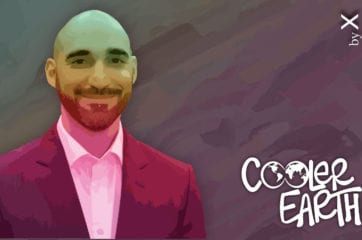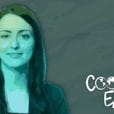There is so much about our current systems that is not working right: from transportation, agriculture, waste management, air pollution, energy generation and distribution, we see inequity and injustice almost anywhere we look, all worsened by the climate crisis.
Wielding the power of the law to change these current realities, and to advance justice and environmental protections is a powerful way to create and codify meaningful, long-lasting change. That is what drives EarthJustice, a nonprofit public interest law organization, committed to preserving natural places and wildlife, advancing clean energy, and to combating climate change.
Today on the podcast, we talk with Adrienne Bloch and Kim Smaczniak of EarthJustice, who are harnessing the power of the law to fight climate change. Bloch leads the organizations Fossil Fuel Program, working to stop the build-out of fossil fuel infrastructure and fighting pollution in frontline communities. Smaczniak heads the Clean Energy Program, where her team advocates for the advancement of clean energy and helps support energy efficiency programs. We talk with both of them about the role the legal system plays in addressing the climate crisis, creating long-lasting change in communities, and the real impact of the widespread rollbacks of environmental regulations under the current federal administration.
While many of these legal battles don’t get the headlines they deserve, they’re the foundation for implementing change at all levels, and one of the most important forces behind the fight for a livable and just future on Earth.
Below is a transcript of the webinar, edited and trimmed for clarity and brevity.

Maria Virginia Olano (MVO): We’re so thrilled to have you on today to discuss one of the most interesting and fascinating areas in the fight against the climate crisis, which is the legal battles and the ongoing legislative ways in which we can fight this and ensure a safe and equitable future for everyone.
How are you both doing? I know that this has been a crazy time. Adrienne, you’re based on the West Coast?

Adrienne Bloch (AB): That’s right, I’m here in Oakland and work in the San Francisco office of EarthJustice.

MVO: How is lockdown going? Are you both still working from home?

AB: We’re working just as much as before, but we’re working from home, so that feels different, a lot of video calls.

MVO: Definitely, I think our lives have been taken over by Zoom. Once again, I’m really appreciative and I know we are all super busy so I hope to keep this succinct and go through some of the questions that we wanted to go over. If we could hear from both of you, and if you want to get us started Adrienne, with your career and path to getting to where you are today as an environmental lawyer and your work at EarthJustice.

AB: I’m the managing attorney of the Fossil Fuel Program, and this program is relatively new, but we work to end oil and gas development and big, new infrastructure projects that lock us into fossil fuels for decades to come. We do that in a way that advances equity—that’s our goal—to center on communities to protect health and invest in their power building efforts as well.
The way that I came here is through environmental justice. I worked for an environmental justice organization for about ten or twelve years as a lawyer, working locally and thinking globally, and it was an amazing experience. But one thing that I saw was the way that communities across the country are engaged in so many similar fights, and that we really need to, especially in the face of climate change, scale our efforts and magnify our efforts to make a bigger movement. That’s why I came to this job, to have that opportunity to scale and magnify those movements and strategize on the legal side of that.

MVO: Maybe we can get into that background and how it influences your work a little further along. Kim, do you want to give us some background about yourself?

Kim Smaczniak (KS): Happy to! I’m really excited to be here today, Maria, and talk about how I came to work at EarthJustice as the managing attorney for the Clean Energy Program. I like to call myself a refugee from the Trump administration. Most immediately prior to my work at EarthJustice, I had been a climate change negotiator with the U.S. State Department. I was part of the team that helped to negotiate the Paris Agreement, and had joined that team with the intention of digging into the many years of work we would need to implement the agreement to halt and mitigate climate change.
EarthJustice’s Clean Energy Program works to advocate and advance clean energy across the U.S. Learn more about program efforts. Read more.
In the wake of the election, like many, I was devastated and knew that I was leaving the government. I knew I needed to go someplace where I would be able to find a space for optimism; something that could get me out of bed in the morning when the news on climate change can seem so heavy and so difficult. When the position opened up at EarthJustice to work on advancing clean energy, I knew that was going to be the place I could find energy and optimism because, honestly, the story of clean energy is that we’re utterly lacking in federal leadership at this moment. There’s so much progress going on throughout the country, state-by-state we’re seeing clean energy—it’s affordable, it doesn’t have all the problems of pollution like fossil fuels. On its own steam, we’re seeing clean energy grow rapidly, and with strong legal and political advocacy we can see that impact magnified.
That is the story of my journey—looking for a palace where I could have impact in a time where we are not seeing federal leadership on climate change.
Our State Carbon Pricing Network (SCPN) supports state-level campaigns across the U.S. working to further climate policy. Anyone can join to get updates on movements in different states. Visit our SCPN Page.

MVO: I can’t imagine that shift. Coming off of what seemed to all of us as a path of hope and international cooperation on this massive issue, and then seeing a new administration come in and one of the first things done in office was withdrawing from the agreement.
That being said, I think it’s so fascinating to have you both join us today because you’re both working on two sides of the same issue. It is the containment and fight against fossil fuels and the expansion of fossil fuels, but also what comes of the other end of that and what happens afterwards—and that’s clean energy. A way in which we can have a future that is not just clean, but is also safe and equitable, and you’re both doing this through the lens of the law.
That brings me to the next question: how do you see the law as such an intrinsic and inherent part in which we can do this work and safeguard some of these protections that we’re seeking?

AB: The law provides a structure for our fights, among other things. I know that Kim will have something even more fundamental to say than that. It provides that ground and that leverage because it’s something that is respected, so to speak, regardless of where you are or your place in this country. It’s really a place where we can really join together. One thing I really appreciate about the law, and something that can actually become a challenge as well, is that sometimes communities can rely too much on the law to actually provide an answer and provide change. But law doesn’t change anything really, it just creates that framework.
I see my role as being a tool that the community can use to advance a larger effort and recognizing that when you think about inequity, a community is not hit with inequity from one place. It’s not just that there are polluting facilities or that there are rests in the community, it’s all of those things. Using the law in one of those places to also help galvanize energy and movement around all of those at one time. I see the law as a tool for communities and for people to create change in society.

KS: I’ll just say that I couldn’t agree with Adrienne more that the law is a crucial tool for creating that change. How does that play out in my work advocating for clean energy? Our theory of the case is that, at the same time we’re opposing the burdens of fossil fuel infrastructure—that we’re fighting against those pollution and health impacts and community impacts—we also need to think about the investments that are going into infrastructure.
Where are those decisions being made? A lot of those decisions being made by state and federal regulators of the utilities who then invest is this large infrastructure. Fundamentally, those decisions of the decision-makers are founded in the law. They’re required to follow certain laws, they’re required to follow certain procedures, and they have to have a certain basis for their decision making. As lawyers, we see that space in which those decisions are happening — the decisions that impact communities in very direct ways—about what investments are we making. Is this clean energy we’re investing in or is this dirty fossil? That’s a space where we can come in with our skill sets, our skills in advocacy in marshalling the law to make good arguments based in good facts, to create that change and that impetus for change. It becomes a key place where we can move those decisions, make our case as lawyers in those proceedings, that often look like mini-trials, to support the case for clean energy.
There the law really is a key tool — not the only tool — there are really important backdrops of advocacy from the community, media outreach, political opportunity for change, but the law is a key moment. It can create those sparks for change by having a case in which you’re really centering on how these issues play out for communities.

MVO: You hit on what I wanted to talk about next, which is what the role of civil action and the groundswell of support that we’ve seen in recent years. Most recently in the last couple months, from people and communities rising up to demand better. Demand better from the political system, and demand better from the justice system. I’m curious as to how you both think of that in your day-to-day work—how does this kind of civil action and massive movements for change complement the legal work that is happening or vice versa?

AB: One of the main campaigns we’re focused on right now is the petrochemical buildout happening in the U.S. One of the things that is so fascinating about it from a climate perspective too is it circumvents our efforts to create a clean energy future because you’re using oil and gas for something other than energy. It’s something that we’re quite focused on, and petrochemicals have a huge lifecycle from the well-head all the way to incineration or plastic waste in our waters. The team I’m on is focused on petrochemical infrastructure, which is primarily being built in low-income communities, and low-income communities of color, in Louisiana, Texas, and the Ohio River Valley. One of the communities we’ve been working with the most is Rise St. James, which is a frontline group in St. James, Louisiana and they are fighting the Formosa petrochemical facility there.
It would be massive—it would emit almost 14 million tons of greenhouse gases a year, which is the equivalent to three and a half coal-fired power plants. It would also release a lot of toxic pollution. It would be the third-largest emitter of ethylene oxide—which EPA has recognized as a cancer-causing toxin. This is a massive fight, and this group came together around this facility fight, so they didn’t exist prior to this proposal by Formosa to build this massive, 14-facility complex in their town. Since then, they’ve been engaged in so many other efforts and are really building power throughout the region, throughout cancer alley—working with other parishes, organizing marches that run the entire 85-mile stretch between Baton Rouge and New Orleans in cancer alley, an area that has been hit so hard for so long. We’re seeing people really rise up and working in their communities, but also going to D.C. and working on changing the laws, and also reaching out to other communities fighting Formosa in other parts of the country and around the world. We’re seeing groups in Taiwan stand up and fight for communities in St. James.
One of the things we do as an organization is try to amplify efforts in communities, so there’s a great opportunity for change in movement building through these projects that are subject to permits. They highlight the oil and gas industry and their social license to pollute and really push climate change beyond what we can imagine.
Systemic racism has resulted in communities of color taking the brunt the impacts of pollution. In the U.S., BIPOC Americans account for more than half of all residents living within three kilometers of a hazardous waste site. Read more.

MVO: That’s also part of what you mentioned there, the need to change the laws and the system in which the laws operate. This is why the role of groups like EarthJustice is so crucial and so critical, being able to provide legal assistance and legal work that otherwise might be inaccessible to a lot of folks trying to do this work on the ground.
What are the ways in which you see the need for more of that? We know that we are opposing the most profitable corporations in the history of the world. They have the ability to not only lobby, but to hire council and effective council, and those on the receiving end of that marginalization, pollution, and the consequences of these projects are unable to access that. How do you think through those barriers and obstacles, and how do you think EarthJustice is playing a critical role in addressing those?

KS: You’re right to point out how asymmetric and how huge the barriers are for a small community group versus a really well funded fossil fuel company or massive utility, with that access to power, that access to legislators. We’ve recently seen this blow up across the country in multiple scandals among utilities in which backroom deals in order to keep dirty coal running for a utility that makes profit on that. They’re able to move tens of millions of dollars into shady offshore accounts in order to get what they need from legislators.
How do you, as a small community, go up against that untoward influence? Even when it’s not unlawful, even when there’s not corrupt bribery at the center of it, there’s still this fundamental problem of access to decision makers. I will say that the law helps level the playing field. When you bring a court case, you force someone on your playing field and they have to deal with you. They have a legal obligation to show up and respond to a complaint. That can be very powerful for a community to bring to the table some powerful interests that otherwise might not want to bargain with you, have ignored your community systemically, failed to provide for you, and don’t want to hear how they’re impacting your community. There’s tremendous value to organizations that can provide the expertise, the know-how to navigate legal proceedings, but also to advise.
What are the ways that you can have access if there are legislative sessions going on? What does that look like to make sure that we’re supporting our partners so their concerns are a part of the consideration? Sometimes that advocacy is knowing that access is not going to be fair and sometimes you have to make the good trouble and agitate and get some notice for your clients where they’re going to be out talking to the press outside a formal proceeding.
I’ll give a concrete example. Our Florida office had been working with LULAC (League of United Latin Amer ican Citizens), a community latinx group, to advocate for energy efficiency while the utility was trying to eliminate those programs that were tremendously valuable to many communities in Florida. They wanted to participate directly with ongoing public hearings, and the commission, the regulator who has control over decisions, was siding with the utility in saying they didn’t want to hear from those communities. We had to get creative as lawyers and say we’ll have a little discussion with the press over here outside as the hearing is ongoing, where you can hear from actual voices of the community and how this will impact them because those voices should be at the table. And if they’re not there, you use every tool at your disposal to make sure those concerns are heard and elevated, and get covered so politicians and decision makers are aware of them.
In Ohio, House Speaker Larry Householder and others were charged in connection with a $16 million bribery scheme from utilities to pass legislation bailing out a coal and nuclear plant. Read more.

MVO: I wanted, if you’re able, to share some of the most rewarding or impactful cases that you have been involved with or seen through. Sometimes for the general public, we can hear about very high profile court cases or decisions that happen, most recently against the biggest fossil fuel companies. But perhaps it’s difficult to understand the significance, the long term impact, and ramifications that those decisions will translate into. I wanted to hear from both of you what are some of the projects you’ve worked on where you can say and see that this is going to have a long term, positive, and significant for the country and the world?
This past summer, both the Minnesota and Washington D.C. Attorneys General sued a number of fossil fuel companies for knowingly promoting false or misleading advertising, arguing that it infringed on state consumer protection rights. Read more.

KS: I want to start by talking about a case that’s probably not the biggest case we’ve ever won, but really speaks to how crucial in this time and moment small advocacy can be and not covered by the press, but has such a huge impact on everyday people’s lives. My team, two fantastic young attorneys, have been working in Michigan to fight for energy efficiency programs that go to benefit low-income customers.
Really important context to understand is that, in this particular area of Michigan, which is served by a utility called DTE, there are tremendous challenges of affordability for many DTE customers. Close to a quarter of their customers face energy costs that are more than double what is considered affordable, and those are figures that predate our current economic challenges. I suspect those numbers are much worse now.
The lack of access to energy efficiency for many of these low-income customers means that these homes that have the highest energy burden are often the most inefficient. They have old appliances, drafty windows, the housing is less comfortable and less safe. This work in Michigan was really motivated by a report by the NAACP which is called “Lights Out In The Cold”. It looked at this problem of electricity shut offs across the country, electricity shut offs because households can’t afford to pay their bills, and they recognized that that is a human rights issue. If, in the middle of winter or a scorching summer, you don’t have access to electricity, that has real human costs. In this case, our attorneys worked with Sierra Club’s Environmental Justice and Partnerships program to ensure that that utility would put in place an energy efficiency program that would target those customers who are most at risk of facing electricity shut offs due to failure to pay bills.
We were ultimately tremendously successful in this case to make sure that not only are we targeting those investments to customers who would be traditionally ignored by those programs, but also to grow the size of those programs so that we’re putting more into energy efficiency. Also, tracking so that we’re able to see the rewards of those investments and going forward to make a case for continuing to grow those programs. While that may be small in scale, when you look at what’s going on across the country at this moment, we need more of that kind of work as so many households are feeling the acute effects of this economic crisis. They are not able to pay their bills, and at some point the moratoriums that have been in place against shut offs are going to end, and that’s an opportunity to make sure we’re both improving the lives of people and addressing these tremendous economic impacts.
The 2017 report “Lights Out In The Cold” provides an overview of utility disconnection policies, and names the many critical issues that need to be addressed in order to develop equitable policy. Read more.

MVO: That is so crucial. Something that often does not get discussed enough in terms of solutions are things such as reducing the burden of electricity costs. Not just through an entire overhaul of clean energy, but through things like energy efficiency and making those investments that are so necessary, not just for working families, but also for the overall reduction of emissions.
I wanted to also touch on the moment we’re living through. It’s not just a devastating pandemic and lockdowns, it’s the ensuing economic and jobs crises that we’re living through in the country and around the world. How do you both believe it’s impacted current work? And going into the future, how are some of these acute moments, where inequity and injustice has been brought to light so obviously for all of us to see, how do you see that impacting legislation and work moving forward?

AB: We’re really seeing the inequities more saliently. Early on in the pandemic, St. John’s Parish in Louisiana had the highest death rate from COVID in the country. People were really able to see the relationship between air pollution and vulnerability to COVID, and death from COVID. That was happening at the same time that we’re seeing killings of Black folks and being able to see the relationship between Black Lives Matter and other inequities. Another part that hits the work directly as well is that it’s hit the oil and gas industry. I would even say it’s been devastating for the oil and gas industry.
The only way that it’s going to be able to find its way back is through being bailed out. Everyday we’re seeing new threats to the oil and gas industry, which is a good thing. They need the price of oil to be $50 per barrel in a certain amount of time, so they’re being hit really hard. This is a very important time to take a hard look and make the most of the laws we have to ensure that they have their proper place in this society and this world, which they haven’t had to do in the past. This is a huge moment when we have an opportunity to put things in their place.

KS: Our team and EarthJustice have been laser focused on this need to focus on energy justice issues, and the disparate impacts of the lack of access to energy benefits and the disproportionate harms of fossil fuels. It’s been an ongoing priority for our team. Seeing the COVID impacts land so hard on communities of color and devastates communities at the same time we’re seeing the backlash of what we still see as fundamental racist institutions in our society, it really puts a hyper-acute focus on the work that we’ve already been moving forward. It’s also such an exciting time to see that we’ve known that this is important, but now we see other parts of larger society recognizing and pointing out the importance of anti-racist work. Building out, for example, more legislative proposals that tcenter equity in the response for climate change, seeing more widespread consideration across institution after institution thinking about environmental justice components of how we do our work. That’s exciting—it gives us a window of opportunity as an advocate to say ‘we’ve already been working in this space and we have some ideas, let’s move on them.’ Using that national mobilization to make sure we’re elevating those good ideas on how to address these deep, systemic challenges we’re facing.

MVO: Certainly. You both said this, but it’s this recognition that we can no longer claim to care about just one thing. You can no longer advocate for environmental justice without taking into account and centering racial justice while you do that as well. It’s been fascinating to watch this reckoning within the environmental and activist space with how non-inclusive many of us have been in the past, and the need to understand these issues comprehensively. Likewise, if you are somebody who cares about housing justice or racial justice, it’s not been very obvious that those are deeply intertwined with the environmental and climate crises that we’re dealing with through air pollution, climate impacts, and heatwaves, and so many other things happening.
I wanted to talk about the complexity of these issues. As we see and understand them, it’s also important to recognize that it can be quite overwhelming for people who maybe don’t understand or are not in this day-to-day. The public understanding of these things and court challenges and legal battles — how does that play into how you think about your work, the need to communicate the depth of the issues we’re living through?

AB: The need to communicate is really essential to winning in the end. There are really difficult aspects to the cases that we bring. A lot of cases on the team I’m on we’re bringing cases under the Clean Air Act and the Clean Water Act, which can be complex and maybe not even that interesting to some people. But, even those can be broken down and really simple ways. For instance, in St. James, the Formosa facility would exceed the national level for certain types of pollution, and that’s easy to understand. There’s this other piece of knowing that we’re working in our lane in the sense of focusing deeply on environmental statues, but at the same time we’re supporting campaigns and not just cases. We recognize that our cases come in the context of larger sets of issues. There’s no such thing as this justice or that justice—it’s one justice. Most of us know that, there’s just one justice. When we are engaged in our cases, we’re alive and awake to all the other pieces, and are able to some extent incorporate that into the cases that we’re bringing. When we’re telling the story of our Clean Air Act case, it includes all these other components and we’re actually able to advise our clients on issues that are still environmentally related, but are a little bigger than the case we’re working on. When we’re communicating, we’re communicating the issue in the community and how that connects to larger issues. We’re not just focusing on the legal issue of the case. As we’ve spoken today, I’ve focused less on the law and that we’re really moored in that because I want to emphasize the fact that the change we’re trying to make is larger than that. We recognize that, we recognize injustice and the reasons that we’re fighting are because of a larger injustice. The reason that these facilities are located in certain communities is not an accident.

KS: For our work, education is a key component. There is a huge demystification that has to happen at the first level. Whether it is to the average person, who knows they get a bill for their energy, but they don’t know the structure behind that. You know the name of your utility, but do you know that that utility buys its power off this regional market that is run by a separate entity.
The average person doesn’t grasp the complexity of that system, so if you need change to happen somewhere upstream in that process and the average person is not even aware that those decision makers exist, that’s a huge gap. That’s a space in which advocacy is not happening because members of the public, who are directly impacted by those decisions, are not even aware of that decision process. A huge piece—setting aside the aspect of the law or the technical issues we deal—is just understanding where these decisions are being made and how they eventually affect you. They ultimately result in the difference between having this polluting infrastructure and facing the real impacts of climate change or not because it’s such a complex system.
Often one of our areas of engagement, whether it’s to community groups or whether it’s to legislators and other potential influencers in this space, is to first explain how these entities are connected and how do these entities ultimately result to what we see happen on the ground.

MVO: Right, and they’re so complicated by design. They’re designed so that regular people don’t understand them. If more of us did know the inefficiencies and inequities, and the outrageous and polluting ways our energy systems work, then there would certainly be more broader calls for change around this.
With some of the final time we have here—and speaking more about the nefarious aspects of the people working to keep the status quo in place and keep these systems operating and profitable for the very few they have been—one thing that’s looming over all of us this year is the federal election. A lot of what we have seen over the past four years of this current administration is massive rollbacks of critical environmental policy and legislation that took decades to be put in place.
Most recently the National Environmental Policy Act (NEPA), which is quite literally stripping away community input into critical decisions for the future and protector of our homes and environments. I want to hear from both of you, as much as you can share—what has been the real impact of all of these rollbacks, and of a hostile administration that is actively working to stack the courts with judges and his cabinet with people who don’t necessarily agree with a lot of the things we’ve talked about?

KS: I will say that, for my team, the impact of the rollbacks and the effort to put in place appointments, who are often industry insiders, has resulted in a lot of work for us. It’s been an exhausting four years. I have such admiration for the members of our organization, our partners, and our clients who have been tireless in showing up to battle after battle. It is a huge amount of work to bring a lawsuit to bring a lawsuit to stop these rollbacks—it is countless hours of people’s time to take all the steps to stop and reverse them. The story is also important; we’ve had tremendous success in fighting those rollbacks.
The deck is stacked in favor of the government, and I can say that as someone who was a former government lawyer who used to defend, at the Department of Justice, these environmental rules put out by agencies. The law is such that most of the time, courts are supposed to leave intact the decision of an agency because it’s the expert. Yet we see that, even in other administrations, the normal course would be that courts would not reverse rules issued by these agencies. EarthJustice and others have been having huge success rates. I think we have a tracker that tracks the percentage of wins, but it’s phenomenally high compared to what would happen in a normal course of administration decision making.
That’s the positive story. With the power of law, with hard work, dedication, and huge partnerships and movements, you can win.

AB: I completely agree with Kim that the effect has been to keep us extremely busy and that we’ve had tremendous success. At a time when we need to slow climate change, we’re having to work extra hard to stop major build outs and to stop these rollbacks. Most recently, there was an attempt to roll back the methane rule. Methane is a particularly potent greenhouse gas and the administration is trying to roll that back so that we can have tremendous flaring at oil well sights. At a time where we need change in one direction, we’re trying to beat off climate impact increases in others. There are also the equity issues that come in the NEPA context that you mentioned, and particularly on cumulative impacts. We’re definitely concerned about that, but we continue to fight because there was a door opened. We’re just continuing to fight these rollbacks and doing a great job, and at the same time fighting the build out, so it’s keeping us really busy.

MVO: We are so grateful for the work that you do everyday, and the work that your colleagues do, and work that is so critical right now. I can concur that it has been an exhausting four years and I can only imagine what that has looked like for you both.









